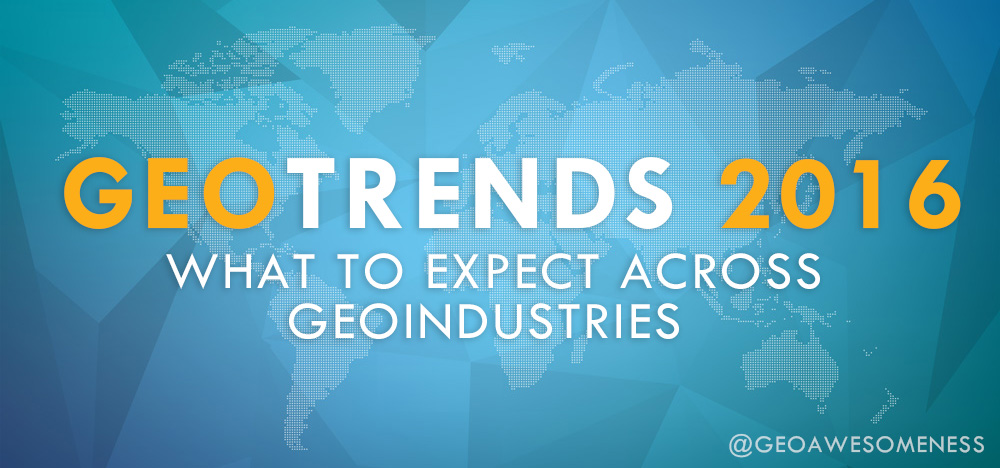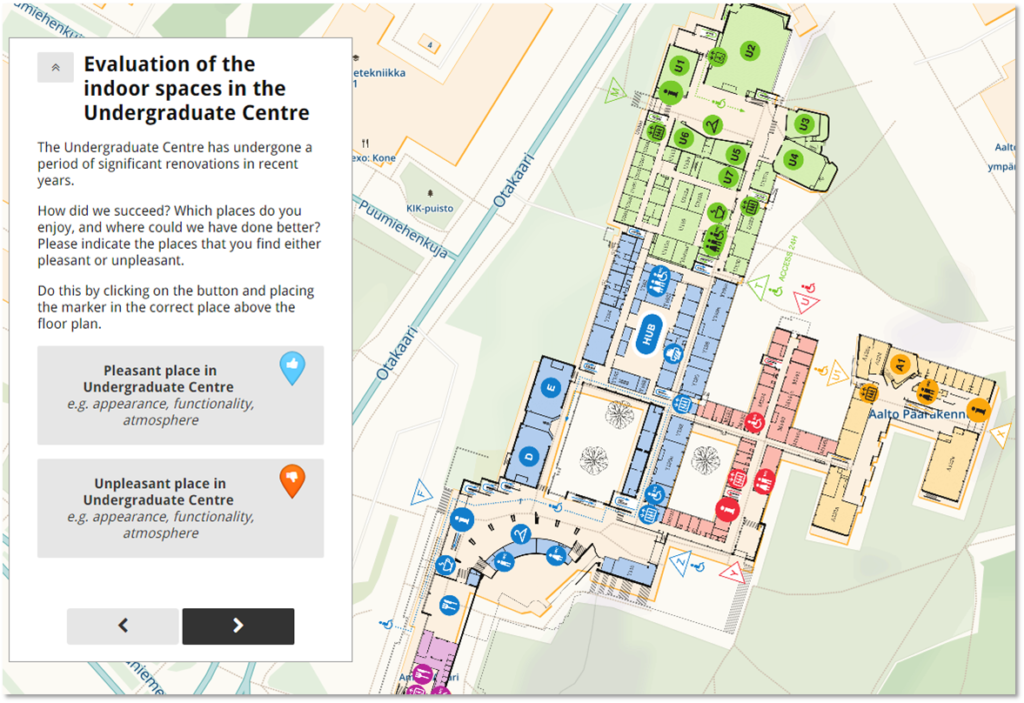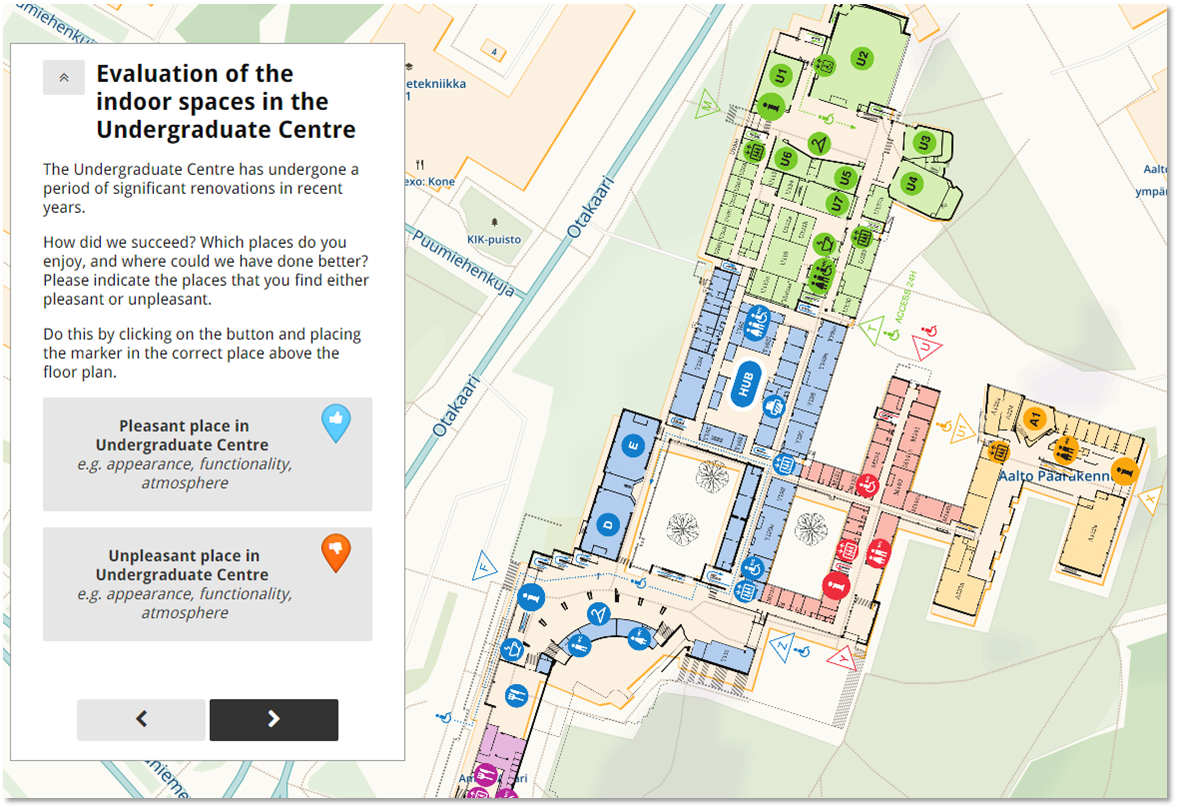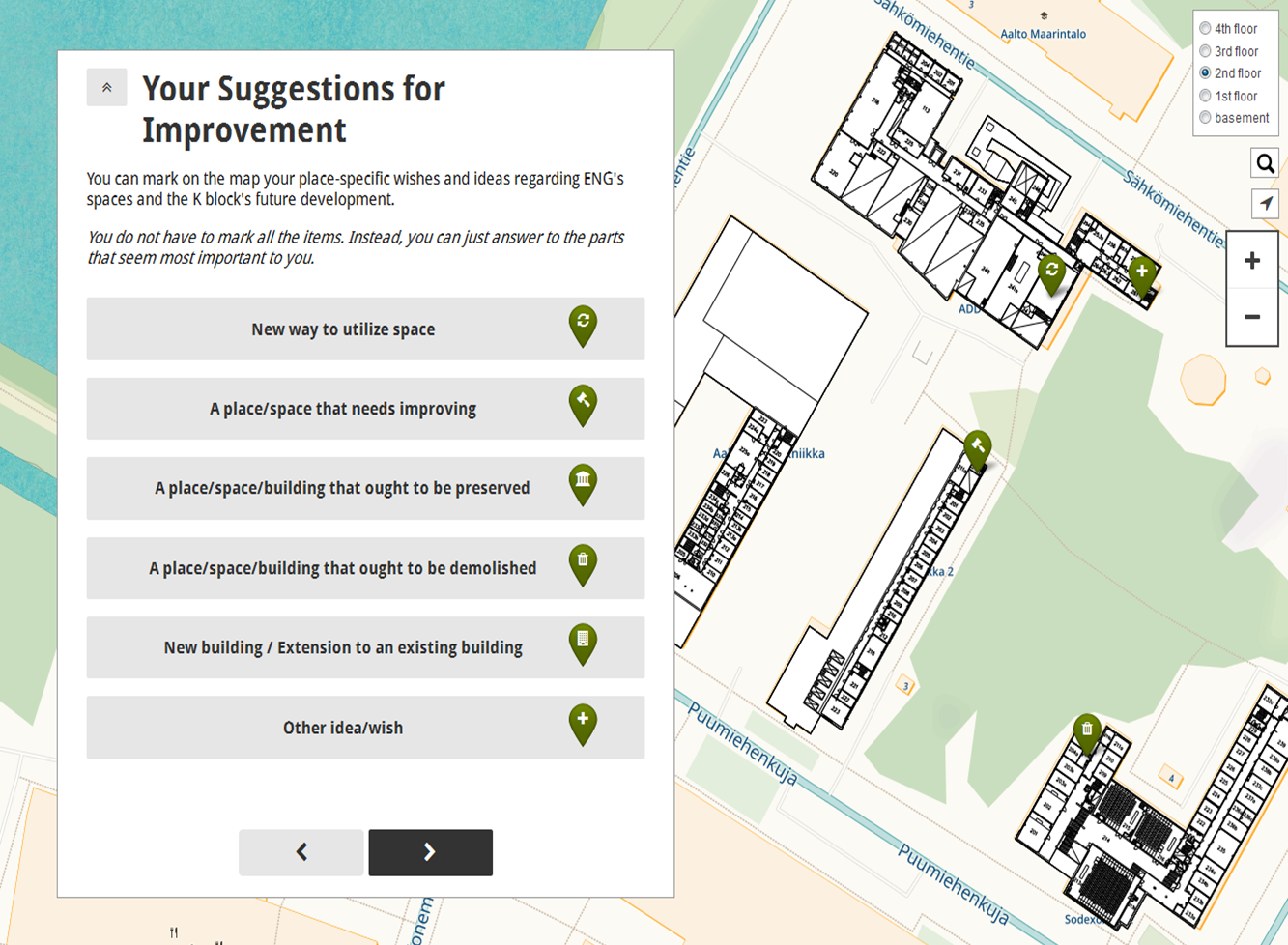
Geotrends 2016 – What to expect across Geoindustries this year?

The new year symbolises the beginning of new start to some and to others it symbolises an arbitrary point in time where the earth has completed yet other lap in its marathon around the Sun.
Speaking of new beginnings, we at Geoawesomeness have always loved talking to other GeoGeeks and listening to their thoughts on where the industry is headed. Instead of letting these conversations just reside in our private spheres, we invited them to share their thoughts and visions with the entire Geoawesomeness community and we are thankful to each and every one of them who took the time to pen their thoughts (in a rather short time) and agreeing to be part of the #GeoTrends idea!
We hope you enjoy reading these thoughts and visions, just as much as we have and let us know what you think about where the year is headed 🙂 Happy reading!

“Considering the top 10 technology trends for 2016 identified by Gartner it shows that these trends are also addressing two issues:
- Technology will provide more data and increase connectivity of everything
- People need or will have the right/better tools to solve real live problems
These trends are influenced by the development in the field of geoinformation in the past or will be visible in trends and development for location-related industry in the future.
In general: Geoinformation will provide the necessary geographic context and tools to understand this data and their spatial relation. Geoinformation has the ability to integrate everything and to let people participate in an appropriate way.
Here my view on some trends in GIS in 2016:
- Collaboration – GIS becomes a platform for the exchange of data across organizations
- IOT / Real-time GIS: GIS will provide the location intelligence for the Internet of Things. In that wave, GIS will be more and more part of the connected car developments.
- Further “Appification”: We will see that commercial-off the-shelf apps will provide geoformation to everyone. Additionally, the spatial analysis capabilities instead of only web mapping in Apps will increase.
- The increase of Geospatial technology in predictive analytics.
- GIS will serve the business. Geospatial analytics will help to solve problems in more and more business areas like HR, supply chain management and logistics.
- Open Data Movement and the Digital Transformation will open the issue of the governance of data.
- Infrastructure planning convergence: The coupling of GIS and BIM (Building Information Modelling) will become natural.”
Jürgen Schomakers
Managing Director
Esri Germany

“2016 will be another exciting year for the geospatial industry. Trends from 2015 will continue and mature this year:
- Indoor: Big IT players and a plurality of startups will conquer this market with very different approaches like beacons, LIDAR and SLAM. It will be interesting to see who succeeds. The number of possible use cases for indoor is still to be counted, but it will be key to integrate with existing GIS solutions. Real estate, facility management and public safety are good examples.
- Drones: Drones will play an increasingly important role in remote sensing. We will see a whole ecosystem grow and the geospatial industry needs to support that. Think planning, operations and post-processing of drone flights, but also marketplaces for drone services and resulting content.
- Spatial context for the Internet of Things: The Internet-of-Things will continue to evolve this year. Wearables and smart home devices are emerging, but B2B applications are still rare. It will be a key challenge to build up a spatial context and will play a key role, especially when it comes down to filtering out the relevant data and extracting meaningful information.
- Big Data and location intelligence: The amount of data that is generated and available (!) is growing rapidly. But organizations are only beginning to make use of it. Machine learning will help to understand and predict the dynamics of phenomena like traffic jams, elections and earthquakes. GIS will support that with the necessary geodata and spatial algorithms.
- Maps and Apps for Automotive: The battle around connected cars and autonomous driving will continue this year. Both are impossible without geospatial technology. Hyper-precise and up-to-date maps as well as real-time analytics of sensor data are just two examples. We will see a lot of geo-enabled apps that get integrated into the car.
- Open Data: Open Data remains a key driver of the geospatial industry in 2016. Governmental institutions, but also corporates will share their digital treasures and allow for a plethora of new applications that can help addressing today’s challenges. Good examples are Copernicus, Deutsche Bahn, the city of Berlin and Esri’s Urban Oservatory.
- Innovation through startups: Startups will continue to push innovation into the geospatial industry. They will play an increasingly important role and the industry will start to embrace that trend.”
Lars Schmitz
Head Developer & Startup Program, Esri Germany


“As geospatial data enters the mainstream, driven in part by device take-up, by social media check-ins and Google maps, we’ve come to expect the ‘where?’ in every interaction we have. We go online to local government websites to view a map which pinpoints our leisure facilities and locates schools; we look at restaurants’ websites to find out visual information on nearest tube stations or bus stops; and we use mapping apps to plan, measure and share our latest running or cycling routes.
In 2016, geospatial data will move from the passenger seat into the driving seat, as businesses glean insights from the data and use it to drive business strategy, to improve customer engagement and to gain a competitive edge. Mobile telecoms companies, for example, will use geospatial data to map out locations with low network signals, to identify areas of investment and offer a better service to their customers. We’ll see insurers continuing to use location intelligence to identify areas of hazard in real-time, with absolute accuracy and precision, so they can make sure they offer the right premiums to the right customers and can be prepared with assessors and loss adjusters in the event of an incident.
This year we’ll also see organisations making more agile use of geospatial data as they integrate it from different sources and use it to influence major business and community transformation programmes. The Oregon Department of Transport is a good example, when trying to identify where and how to build bicycle lanes. Using cycling app Strava, the department identified where Oregon’s residents sped up or slowed down, where they rode on the pavement or on the road and identified traffic patterns across the city. With precise and accurate location on cyclists’ behaviours, the department could make informed, risk- averse planning decisions.
In 2016, organisations will continue to realise the power and impact of location intelligence and we will see even more creative and diverse applications and examples of LI driving transformation.”
Dr Marc Hobell
Direction of GIS and LI
Pitney Bowes

“The maps being built today are very different from those we grew up with. This is particularly true of maps designed for highly automated and fully autonomous cars, a whole new category of map. These maps are for machines rather than humans.
Like most, we do not see a binary switch to full automation on the road. Rather, there’ll be a series of steps towards automation, each of which will require the driver placing a little more trust in the vehicle’s ability to successfully plan driving maneuvers and strategies. The driver – and the vehicle’s occupants – need to accept and be comfortable with this evolving driving experience. Drivers have to trust that vehicles are always acting on their behalf in order to relax and be relieved from the burden of certain driving decisions.
For a vehicle to take on a greater role in determining driving maneuvers, many sensors are required – such as camera and radar. While these sensors alone could enable a vehicle to drive itself, we believe it would be an uncomfortable driving experience that wouldn’t inspire confidence. From our discussions with OEMs and system vendors, it’s clear that the industry has determined that it needs a new kind of intelligent sensor – a living map that provides the vehicle with an awareness of the road environment beyond the reach of its other on-board sensors.
By giving vehicles the ability to effectively ‘see around corners’ we can enable them to anticipate road hazards in advance and prepare and adjust driving strategies accordingly in a way that increases driver trust. For a vehicle to plan the appropriate driving strategies, it must have an almost real-time, clear and uninterrupted understanding of the environment in which it is travelling. This is something that existing car sensors cannot provide. In fact, we believe that if we fail to meet this need, the increasing automation of vehicles will be a hard-sell to consumers and the technology’s chances of success would be significantly compromised.”
VP Strategic Program Management
HERE
 “The best way to predict the future is to better understand the past. And one thing we can confidently say about the past is that since the dawn of the word ‘data’ our use of it in vocabulary has far underpaced the creation of the real stuff it describes. Today, people are wise to data. It is changing the face of sports, politics, and your sleep patterns. In the geospatial fields, for most of my career, data has been woefully difficult to track down and put to use. But those early seeds of change we all sowed are starting to show their springy little heads. Momentum behind OSM has become so big that major portions of it have shifted from data collection to finding the best ways to put the data to good use.
“The best way to predict the future is to better understand the past. And one thing we can confidently say about the past is that since the dawn of the word ‘data’ our use of it in vocabulary has far underpaced the creation of the real stuff it describes. Today, people are wise to data. It is changing the face of sports, politics, and your sleep patterns. In the geospatial fields, for most of my career, data has been woefully difficult to track down and put to use. But those early seeds of change we all sowed are starting to show their springy little heads. Momentum behind OSM has become so big that major portions of it have shifted from data collection to finding the best ways to put the data to good use.
The early adopters of open data portals are evaluating their first experiments and pushing data creators to do something more. We are seeing lots of fledgling OS libraries being released to help enable and train the next generation of data elite. And exploring and extracting value from data has shifted from an expensive desktop software world to something you do in your browser. Swirling inside all of that, I’m a firm believer that the geospatial dimensions are the pins that pierce the diversity of data coming available. For me, 2016 will be remembered for the esoteric and excitingly new approaches to geospatial data analysis that will inch energizingly close to the mainstream of data science.”
Andrew Hill
Chief Science Officer
CartoDB

The world will come open
“In 2016 every technical innovation will have a spatial component. Every single one. And as open data and open source tools become better and the stranglehold on proprietary remains fierce, more and more of the authors of technically innovative work will be investing in open geo. And the breadth of this umbrella is larger than ever. From the start-up in the garage, to federal transit agency, to the large company campus, to the academic ivy tower, all scales of organization will be turning towards open.
Mobility diversifies
A lot is happening in the mobility space. We have the sale of HERE in late 2015, the constant promise of self driving cars, and the fleet of smart bikes to go with your smart phone. With all this excitement, we are going to need mobility and navigation tools that emphasize flexibility and choice. Open tools are the only way to address the various mobility challenges of the car, bike, train, feet and jetson future.
Smartphones are the new black
This shouldn’t be breaking news to anyone. We’ve been on this call for a while. More and more of our digital life is mobile and 2016 keeps that signal four bars. This isn’t your grandparent’s desktop map. 2016 is a world where a map in all its functionality and an app in all its location awareness, is always at your fingertips (or in your back pocket). At. All. Times. The maps we build need to prioritize mobile design and software development principles.
Design goes virtual
Map design is not stuck in 1990s pngs of federated portals. Map design in 2016 will rely on modern aesthetics and developer motifs. And these motifs do not borrow from 2D fine art schools but looks to the next generation of games, animations, and virtual reality. Our maps and our map experiences will reflect this new aesthetic and will require development artistry and fine control. This craftsmanship only happens with detailed access to the data and tools behind the pretty (map) picture. Open gives you detail, control, and access for the next generation of design.
Search gets easier
Finally. Since the beginning of (mapping) time, finding that special something on the map has been a challenge. And the technical tools for searching for that something have often been too expensive, restrictive and cumbersome. With the investment into modern tool chains, open mapping, and mobile mobility, searching the map is going to get a lot easier. Finally.”
Alyssa Wright
VP Partnership & Business Development
Mapzen

Recognising a global Issue
“The lack of a consistent global address system will come to a head in 2016. The value that such a system can provide will drive global organisations to test and embrace new methods for fear of losing ground to competitors, increasing costs and customer dissatisfaction. This is evidenced by initiatives that The United Nations Economic and Social Council (ECOSOC) are looking at with the UN Global Geospatial Information Management (UN-GGIM) to provide a single, coordinating body to help guide the 194 UN Member States on important global topics including addressing. what3words is actively supporting the topic of addressing across the UN system and will be speaking on their efforts in this area at the UN-GGIM Fourth High Level Forum in Addis Ababa in April 2016.” Steven Ramage
Changing the face of logistics & delivery
“Thanks to platforms like what3words and innovations by others in the logistics space, delivery locations will move beyond home, office and fixed drop boxes, to any 3mx3m location; and from fixed 4 hour time slots or within the hour to time slots of minutes. Door-to-door delivery will finally become possible for the first time in parts of the world which have lacked it until now, and last mile delivery will cease to be a cost drain. In many regions, cross-border ecommerce & delivery will overtake local as address validation and economies of scale in international transportation further reduce friction. It is going to be a good year.” Giles Rhys Jones
Location at the heart of technology shifts
“The precise communication of location is at the centre of the key global technology shifts. Simpler location input by voice & text will revolutionise how we communicate destinations to smartphones, wearables and cars. The rise of UAVs will mean consumers and devices will need to embrace accurate location referencing as street addresses will never offer adequate precision and coordinates are prone to communication error. On-demand delivery will force logistics businesses to count seconds as valuably as minutes – clarity around addresses will be essential rather than a luxury.” Chris Sheldrick

“2016, the year of geospatial as a service.
Services and APIs have been around the geo scene for a while, but this year I think we can expect a great deal of activity around the idea of plugging into services for:
- Background maps (Mapbox, ESRI, Google, Apple),
- Data management & distribution (CartoDB, GIS Cloud, ESRI),
- New imagery (Planet Labs, DigitalGlobe, Urthecast, Astro Digital)
In reality, it will be quite possible (normal?) to create distributable geospatial technology without any need for desktop technology whatsoever. Beyond this though I think we will see a deeper level of service based geospatial technology as we observe remote sensing companies moving away from delivering imagery, but instead delivering alerts or notifications of change. Getting to this point, which is really the consumerization of specialized scientific data is very exciting indeed.
Services and increasing amounts of data will be themes for 2016. Personally, I would like to see a greater level of care being taken with the production and design of web maps. Just because we can put a gazillion points on a map does not mean that we should. Closer attention should be given to how the story of a map integrates into the rest of a web presence. We are well beyond the point when we should be satisfied with simply “getting the map to work”, let’s make our maps awesome!”
William Cadell
CEO
sparkgeo







